Spice up your dishes with the mighty Cilantro, also known as Coriander! This culinary herb has been rocking taste buds worldwide and guess what? You can devour the entire plant and boost your health with its amazing nutritional benefits!
Behold the wondrous plant that thrives in hydroponic systems! This fiery herb sprouts with ease and blossoms with lightning speed in hydroponic environments.
- Related article: Which Hydroponic Plant Is Easiest to Grow?
Our discussion will cover the advantages and disadvantages of cultivating cilantro hydroponics, along with techniques for growing fresh herbs like cilantro using a hydroponic setup.
Why Grow Hydroponic Cilantro?
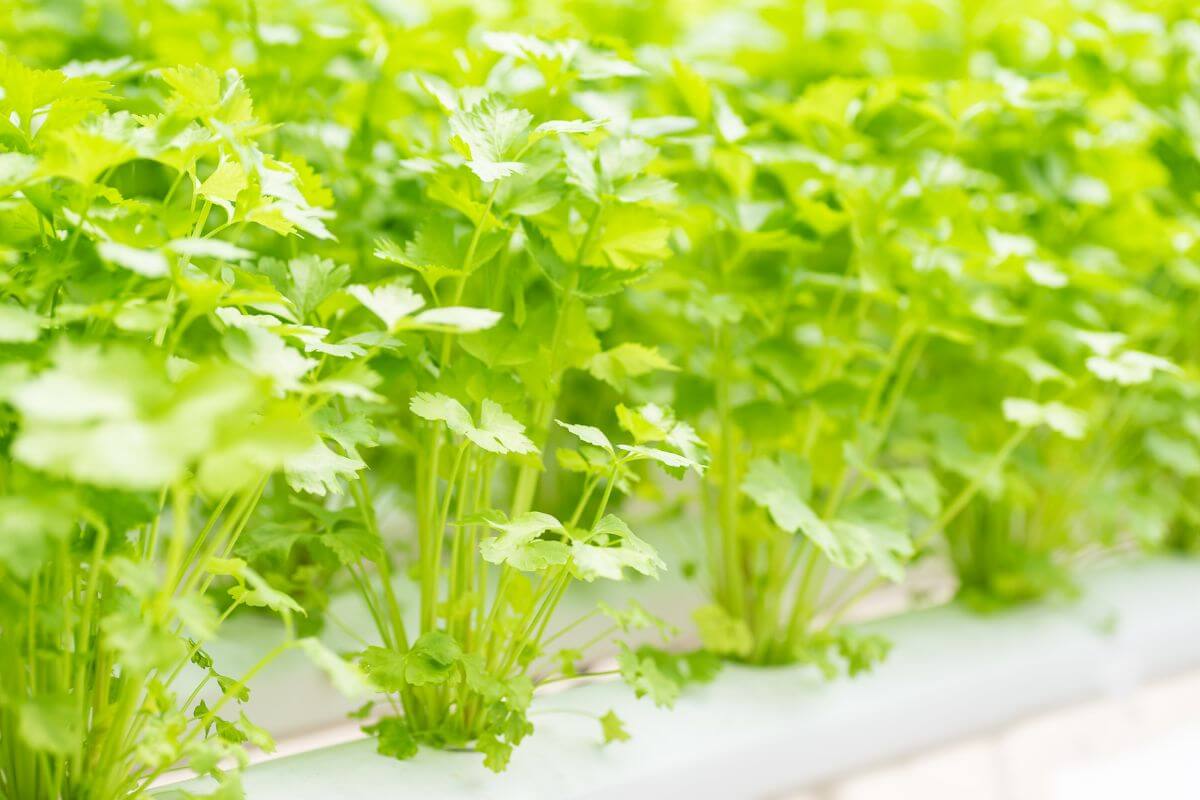
Benefits of Growing Hydroponic Cilantro
The benefits of growing hydroponic cilantro are:
- Cilantro grows faster in a hydroponic system.
- Hydroponic cilantro produces a better taste compared to soil-grown cilantro.
- Growing cilantro in hydroponics uses less fertilizer and water.
- There are fewer pests associated with hydroponic farming.
Drawbacks of Growing Hydroponic Cilantro
Here are some common drawbacks to growing hydroponic cilantro:
- The basic setup cost for hydroponic systems can be high due to the need for expensive equipment.
- The equipment uses large amounts of electricity.
- Water-borne diseases pose a greater risk of fatality compared to soil-borne diseases.
Equipment Needed to Grow Hydroponic Cilantro
Various hydroponic techniques are utilized for plant growth, and each method entails specific technical needs and equipment.
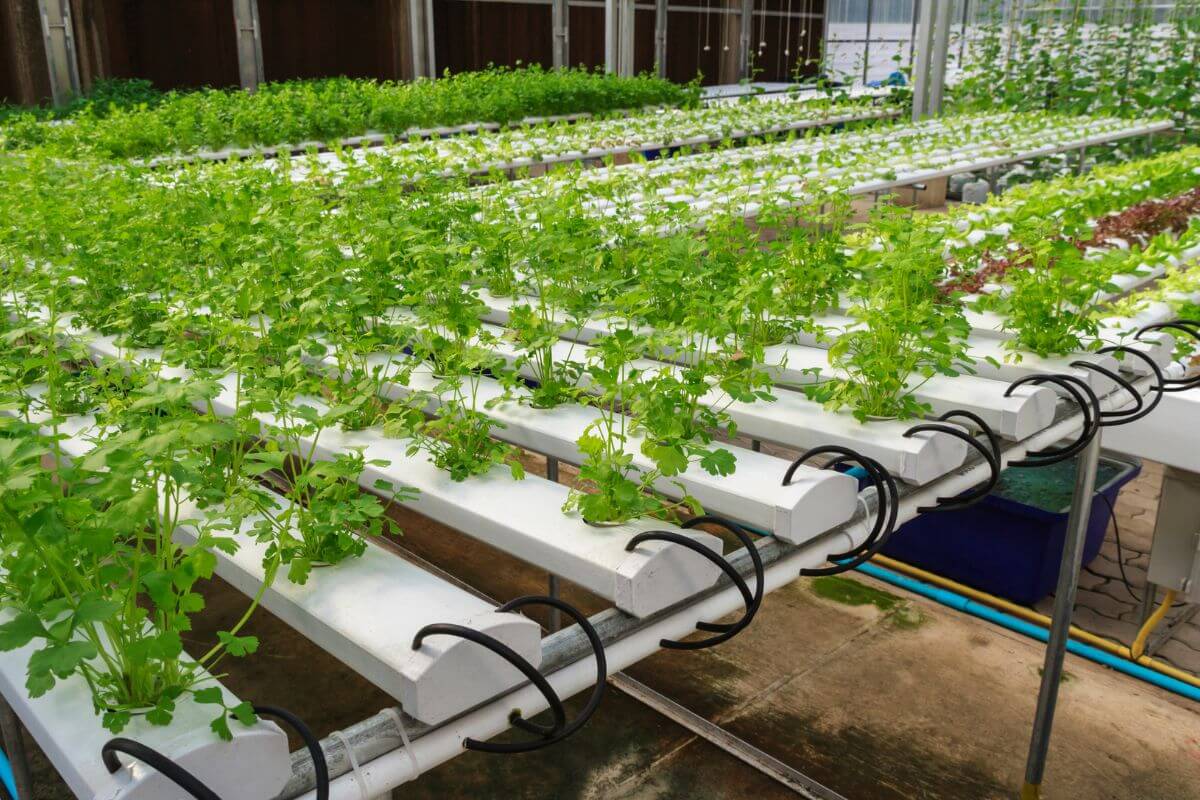
The following equipment is frequently used for cultivating cilantro:
- Air stone/Air pump – In hydroponics, an air stone is utilized to supply oxygen to the nutrient solution, while an air pump generates the necessary pressure to push air through the stone.
- Container/Water reservoir – Hydroponics involves the use of a container for plant growth and a water reservoir to store and provide the necessary nutrient solution for the plants.
- Grow lights – Artificial lights used in indoor hydroponic gardening to provide the necessary wavelengths of light for photosynthesis.
- Water pump – Used to circulate the nutrient solution in a hydroponic system.
- Fan – Used to move air around the growing area. The action of providing a stable and well-oxygenated environment helps to prevent the growth of mold and mildew on plants.
- Heater – The hydroponic system’s trusty sidekick that keeps plant growth at its prime by regulating temperature to perfection.
- Growing medium – A substance utilized in hydroponics to facilitate plant growth and provide a base for the roots to anchor onto. Examples of commonly used growing mediums are rockwool, perlite, vermiculite, and coconut coir.
- Nutrient solution – A liquid mixture of plant nutrients utilized for feeding hydroponically grown plants. This solution contains macronutrients such as nitrogen, phosphorus, and potassium, as well as micronutrients like magnesium and calcium.
- Grow trays – Containers utilized in hydroponic systems to support plant growth. These trays often have holes or cutouts that allow the plants to grow through and access the nutrient solution.
- Net pods – Small, plastic cups or baskets that hold the plants and growing medium in a hydroponic system. These net pods typically have a mesh bottom that allows the roots to grow through and access the nutrient solution.
- Piping – Used to transport the nutrient solution through a hydroponic system. The materials that can be included are flexible tubing, PVC piping, and other types of plumbing materials.
The list provided includes common equipment required for starting a hydroponic system. Additional items may be necessary based on the specific type of system being utilized.
How to Grow Hydroponic Cilantro
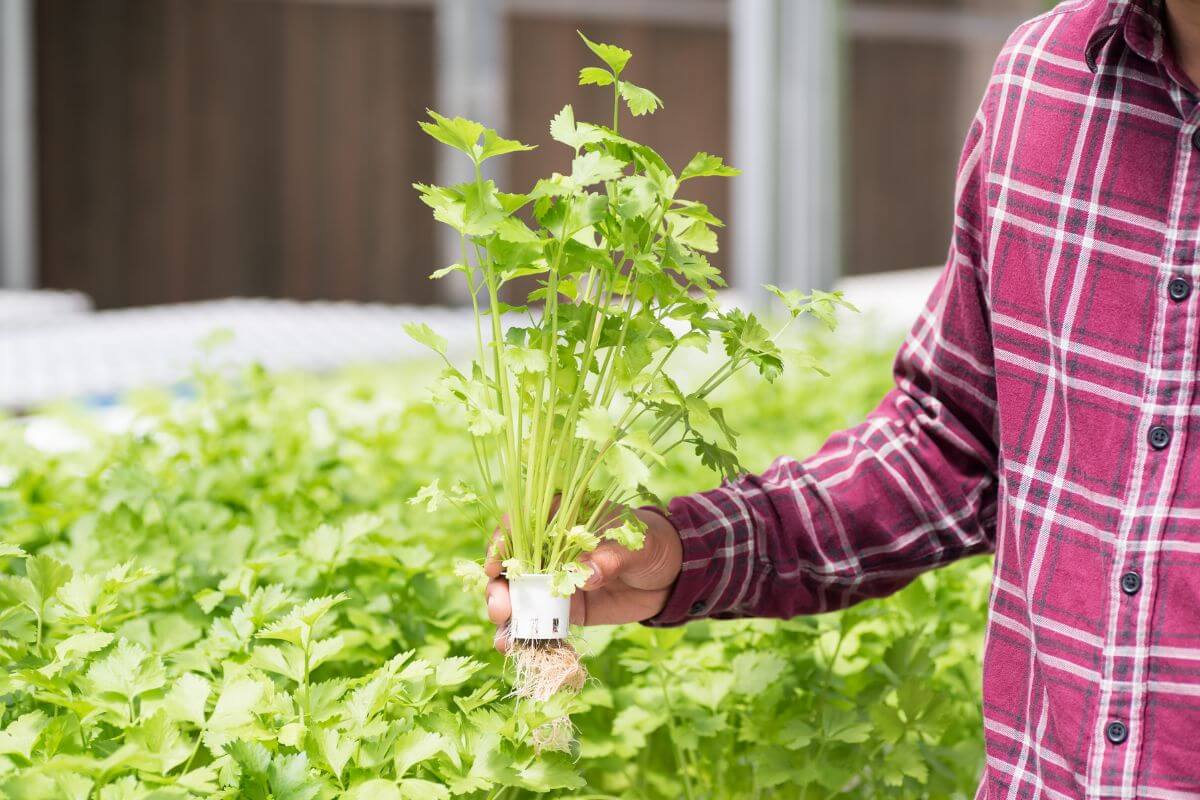
1. Choose the Cilantro Variety to Grow
Embarking on your hydroponic journey? Nailing down the perfect cilantro variety is key to cultivating a thriving system.
There exist numerous types of cilantro that can be cultivated both traditionally and in hydroponic systems.
The most frequently grown varieties of cilantro in hydroponic systems are:
- Calypso Cilantro – A variety with a mild, sweet flavor and slow-to-bolt characteristics, making it a good option for hydroponic growers.
- Slo Bolt Cilantro – A type that is slow to bolt, meaning it takes longer to produce flowers and go to seed. This results in a longer harvest period and a milder flavor compared to other varieties.
- Santos Cilantro – Grows at lightning speed and produces big, bold leaves bursting with a spicy kick. This herb is a staple in Mexican cuisine, especially in the beloved salsa.
- Moroccan Cilantro – A variety that is commonly used in North African cuisine. It has a strong, distinct, excellent flavor and can also be used as a spice in cooking.
- Lemon Cilantro – A type with a strong lemon aroma and flavor. It is often used in Mediterranean and Asian cuisine.
- Leisure Cilantro – A fast-growing variety with a mild, delicate flavor. This food item is suitable for inclusion in salads, soups, and as a decoration.
- Delfino Cilantro – A kind with long, feathery leaves and a strong, lemony flavor. It is used in many Asian and Mexican dishes.
- Costa Rica Cilantro – A variety that is slow to bolt and has large, flavorful leaves. It has a slightly sweet taste and is often used in salsa, guacamole, and other Latin American dishes.
Maximize your harvest with these hydroponic-friendly varieties! With their reduced tendency to bolt, you can enjoy bountiful yields up to three times before it’s time for a refresh.
2. Choose the Hydroponic Technique for Cilantro
Hydroponics offers numerous techniques that cater to the specific needs of various plants.
Cilantro is capable of being cultivated using various hydroponic methods, although there are some techniques that are commonly favored by growers.
The preferred hydroponic systems for growing Cilantro are:
Ebb and Flow Hydroponics
The Ebb and Flow (Flood and Drain) technique is a method of hydroponic gardening where the nutrient solution is periodically flooded into the grow tray before draining out back into the reservoir.
This allows plants to receive regular access to oxygen as well as all the necessary nutrients they require for proper growth.
Deep Water Culture (DWC) Hydroponics
Deep water culture is a hydroponic technique that suspends the roots of a plant in a nutrient rich, oxygenated water solution. Cilantro is commonly commercially-farmed using this hydroponic technique.
Nutrient Film Technique (NFT) Hydroponics
The NFT is a hydroponic system that uses a shallow stream of water, to pass over the roots of the plants. The bare roots of the plant will be able to absorb nutrients from the water, as it trickles past. This technique is commonly used for growing cilantro.
Drip Hydroponic Technique
The Drip Technique in hydroponic gardening utilizes a drip system to supply plants with nutrients and water. By gradually dripping nutrient-rich solutions onto the roots of the plant, the technique enables the plant to absorb all the necessary nutrients for growth.
Aeroponics Technique
Aeroponics is a hydroponic growing method that utilizes a misting system for nutrient delivery. The roots of the plants are suspended in air and sprayed with nutrient-rich water, providing them with oxygen and essential nutrients for growth.
3. Light and Temperature Conditions

Growing cilantro indoors in hydroponics has its advantages. You are able to mimic the ideal growing conditions, all-year round.
Cilantro requires 12-14 hours of light per day and grows best at moderate temperatures between 45°F-70°F.
4. Water and pH Levels
Don’t drown your hydroponic plants in just any water! Before filling up your reservoir, make sure to use watee from a trustworthy source and give it a thorough analysis.
Keep them thriving by checking pH levels before and after nutrient additions, and make any necessary adjustments to ensure their growth never takes a dip.
Cilantro thrives in water that’s slightly on the acidic side, with a pH level of 6.5 being the sweet spot for hydroponic cultivation.
Maintaining a pH level of 6.0-6.5 is recommended for optimal nutrient absorption.
5. Hydroponic Growing Medium for Cilantro
Deciding on the correct growing medium for your hydroponic system will be dependent on the type of hydroponic technique that is used.
Hydroponic cilantro is commonly grown in Deep Water Culture systems, and the preferred growing medium for this technique is Rockwool.
Rockwool, otherwise known as Stonewool, is primarily used for germinating seeds in a hydroponic system.
This growing medium is able to retain large quantities of water and air, assisting root growth.
6. Nutrient Solution
Cilantro is grown for its tasty, green leaves, and this plant doesn’t produce any fruits and is mainly vegetative.
A correct nutrient solution containing high levels of nitrogen and phosphorus is ideal for vegetative plants.
It’s best to maintain low to medium levels of electrical conductivity in your hydroponic nutrient solution. The ideal EC levels for growing cilantro are between 1.2-1.8 for optimal plant growth.
7. Pollination
Growing plants in a hydroponic system will come with its unique challenges—pollination is one of the tedious challenges for indoor hydroponic farmers.
Pollinating your cilantro plants can only be achieved when your plants reach maturity and start to flower.
Pollination can be achieved with a powerful ventilation system. Indoor hydroponics may be sheltered from the wind, but the pollen from a plant can be transferred to other plants with the help of a strong ventilation system.
The best method of pollinating your hydroponic cilantro plants is by hand. You will need several flowering cilantro plants in order for this to be effective.
You can either repeatedly bush your hands through your plants, or take a male flower and rub it against female flowers.
8. Pruning the Plants
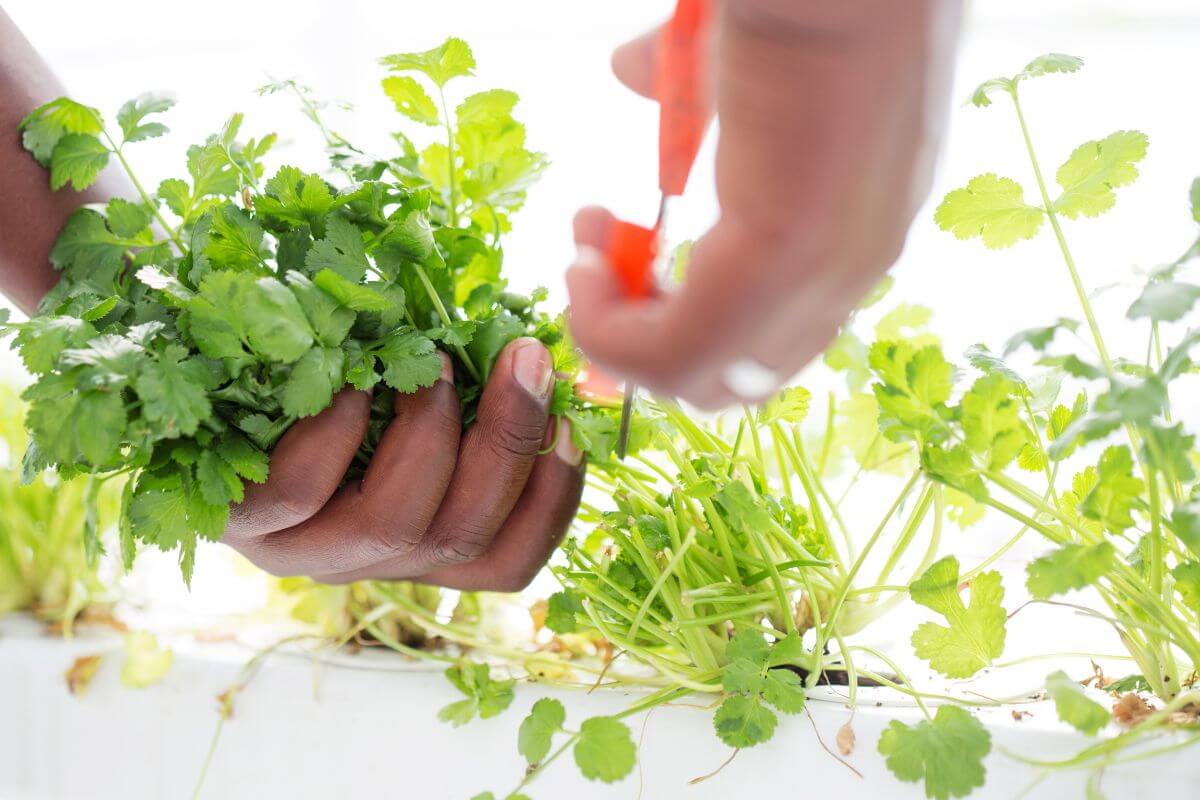
When growing hydroponic cilantro plants, it’s unnecessary to prune the plants since you will be harvesting leaves and stems.
If there are yellow leaves present, it is recommended to remove them from your hydroponic garden.
9. Propagating Hydroponic Cilantro Plants
The cilantro plant is grown from coriander seeds, and this seed is rather large and easy to handle.
Propagating cilantro seeds can be done by placing individual seeds in pieces of Rockwool cubes or a grow tray. Proper hydration and moisture maintenance are crucial for the seeds.
Do you want your seeds to sprout like crazy? Keep the temperature between 68°F to 78°F!
Your patience may be tested though, as germination time can vary from just a few days to a couple of weeks.
Once the little seedlings are done with the germination process and have sprouted, it’s time for them to take a dip in your hydroponic system!
10. Harvest the Cilantro
Experience the full potential of cilantro! This versatile plant can be harvested at any stage of its growth, and every part of it is edible.
The cilantro plant can be harvested as cilantro microgreens while it’s young, or at a later stage.
Coriander seeds are commonly used for their strong flavor and can be utilized either ground or whole.
After harvesting, it is advisable to store the seeds in a dry location with cooler temperatures.
Troubleshooting Hydroponic Growing Cilantro
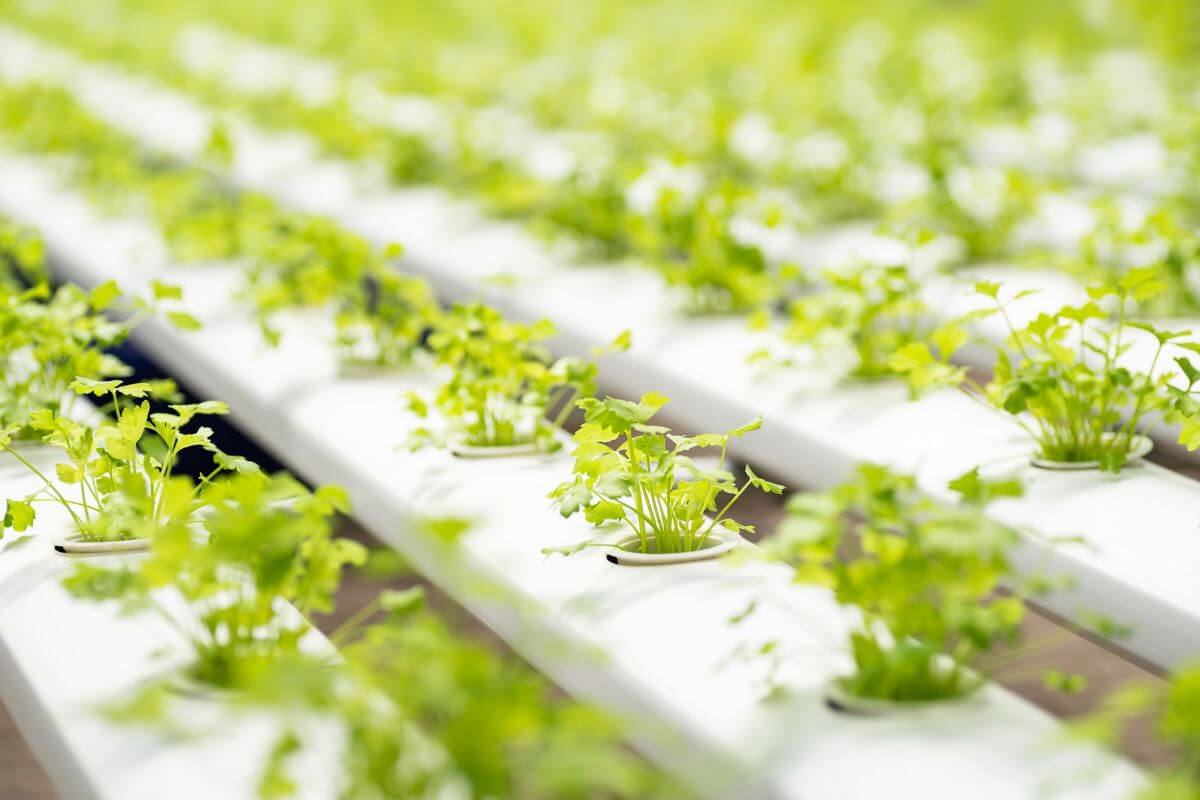
Hydroponic cilantro cultivation is generally simple, although there may be some common growth issues encountered.
We will examine the typical issues, pests, and illnesses associated with cultivating hydroponic cilantro in greater detail.
Common Growth Problems
One of the common growth problems experienced with growing hydroponic cilantro is that its seedlings can become leggy.
Lack of sunlight causes cilantro seedlings to become leggy. One solution to this issue is to utilize more powerful grow lights or to position the seedlings nearer to the light source.
Cilantro leaves may change color to brown or black, which could signal issues with the roots or excessive watering.
The problem can be prevented by ensuring sufficient drainage of excess water in your hydroponic system.
Yellow leaves on a cilantro plant may indicate either a deficiency or excess of nutrients.
A solution to this problem is to use a recommended nutrient solution guide and test the EC levels in your water.
Common Pests on Cilantro Plants
The green leaves of cilantro plants will always seem inviting for both flying and crawling insects.
The presence of pests can vary between an outdoor garden and an indoor hydroponic garden.
One benefit of utilizing an indoor hydroponic system is the reduction in pest presence.
The most frequent pests that can affect your hydroponic garden are Aphids, Spider Mites, Gnats, and Whiteflies.
These pests can be prevented by regularly spraying organic pesticides, spraying Neem oil, or using insecticidal soaps.
Pests will always target weak plants. Prevent pests from infecting your hydroponic garden by removing problematic plants from your hydroponic system.
Common Diseases for Hydroponic Cilantro
Hydroponic cilantro is prone to couple of diseases, especially fungal diseases such as Bacterial Leaf Spots and Powdery Mildew.
Should you notice the leaves being covered by a white, powdery substance, remove the infected leaves from the plant before they spread throughout the whole system.
Bacterial Leaf Spot can be identified by the black spots it causes on the leaves of your plants. This disease occurs in areas with high humidity, making it a common problem for hydroponic growers.
The best disease prevention for this would be by regularly spraying copper fungicide on the leaves of your plants.
Final Thoughts on Growing Cilantro Hydroponically
In today’s world, cilantro hydroponics is becoming increasingly popular as a sustainable and efficient way to grow this versatile and leafy herb.
By using hydroponics systems such as air pumps, water pumps, grow lights, and more, growers can cultivate a wide range of cilantro varieties including Calypso, Slo Bolt, Santos, among others.
Whether you are a home gardener, chef, or commercial grower, learning about the many benefits of cilantro hydroponics and experimenting with different varieties can add a new dimension of flavor and sustainability to your indoor garden endeavors!
Check out these interesting articles to know more about growing hydroponic cilantro:



